Social Media Recruitment Trends Redefining How We Hire
Over the past decade, emerging social media platforms have forever revolutionized talent acquisition. Social media recruitment, which used to be a fringe approach, has now become a serious hiring strategy for most companies.
According to Betterteam, a striking 94% of professional recruiters use social media to network and post jobs. It has become one of the most popular forms of acquiring talent, overtaking traditional recruitment methods such as employee referrals, job boards, and job ads. Recruiters’ widespread adoption of social media platforms demonstrates their usefulness and viability for businesses.
Social media is becoming increasingly popular for job seekers too. According to CareerArc’s 2021 Future of Recruiting Study, 86% of job seekers use social media in their job search, not only to find relevant jobs but also to apply for them and engage with company content. The same study also found social media and social recruiting software to be employers' number one tech investment in 2021.
Social media is a powerful tool for finding quality candidates. More than half of the world’s population uses social media – 58.4% or 4.62 billion people globally.
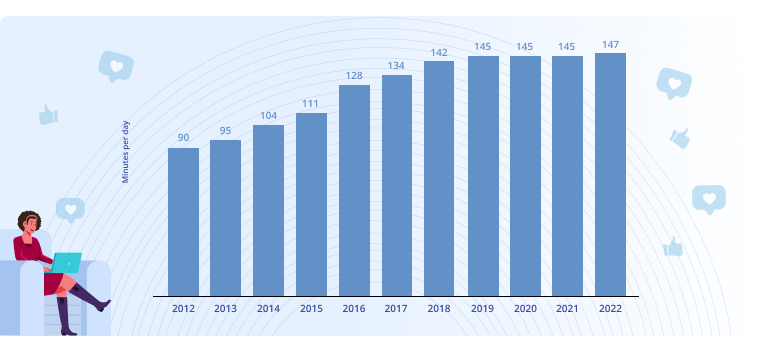
In addition, the amount of time people spend on social media is increasing. In 2022, internet users’ average daily social media usage was 147 minutes, an increase from 145 minutes last year. With an increase in the volume of users and per capita time spent on these platforms, social media has become an indispensable tool for talent acquisition.
In this article, we’ll discuss social media recruitment trends, specifically covering the nature of social media recruitment as well as leading platforms and the various benefits they offer.
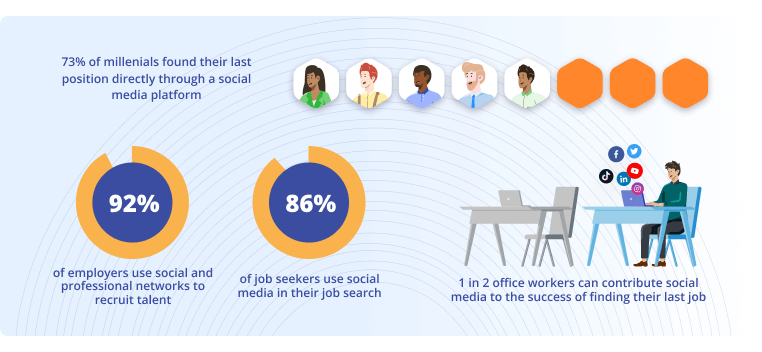
Sources: Social Media Recruiting Statistics and Future of Recruiting Study
What is Social Media Recruitment?
Also known as social media recruiting or social hiring, social media recruitment is the process of leveraging social media to gain access to a robust talent pool. This includes identifying, engaging, and vetting qualified candidates in order to make the most appropriate choice for your company.
Traditional recruitment methods take more time and money, making them a less worthwhile option. Some job sites and job boards charge recruiters on a cost-per-click basis. Since job openings usually receive a large number of applications, this can become a costly affair. Moreover, traditional methods might not give you the reach you need to attract high-quality talent.
Why Is Social Media Recruiting Important?
Social media recruiting is important because the employee demographic is changing. Millennials who frequent social media platforms have started to comprise of a higher proportion of the workforce and are starting to occupy leadership positions. They recognize the power of social media and are not afraid to seek out their ideal candidates on these networks.
Recruiters will also have to rapidly adapt to these changing external factors to ensure they get access to the best talent in a competitive environment.
Before you can delve into social media recruiting, your company, and your company advocates, should have an online presence. If you’re not a well-known company, having employees with a social media presence helps with establishing trust, authenticity, and authority.
Keep in mind, different social media platforms have different audiences. You should consider your objectives and target employee demographic before determining which social media platform maximizes your return.
What Social Media Platforms Should You Consider?
If you’re considering getting started with social media for recruitment, here is a breakdown of the demographic on the most common social media platforms.
Over the years, LinkedIn has become one of the most popular social media platforms for networking with and recruiting candidates. It’s designed to bridge the gap between recruiters and employees and to foster engagement amongst people with similar interests.
A typical LinkedIn profile allows candidates' social media profiles to detail their academic and professional history and emphasize their skills. Recruiters can assess whether the candidate is the right fit for a position by analyzing their profile in the context of the job requirements. LinkedIn offers both free and premium paid services for recruiters and employees.
With more than 58 million companies listed on LinkedIn:
- 95 job applications are submitted every second
- 50 million people are searching for jobs each week
- six people are hired every minute
LinkedIn has become the leading social media platform for recruitment.
An effective way to connect with more potential employees is to create a LinkedIn page for the business to post job openings. With free LinkedIn services, recruiters can share jobs, send unlimited messages within their network, and search for candidates within connected circles. However, with the free service, recruiters can only access six search filters and have to manually manage communications and pipeline status.
The paid version offers advanced tools to find potential hires. For example, recruiters can leverage 40+ advanced search filters, send 150 monthly messages to any of the 800 million platform members, and access a tailored talent pool. Additionally, recruiters can create a career page to display their company culture and post job openings. This helps the job opening get more traction – approximately 19 times more job views. Recruiters can also leverage paid ads to get higher click-through rates.
Lastly, don’t forget to surface your hiring needs to your employee advocates. Oftentimes the candidate's experience in their own networks rivals their own or that of your target market, and it makes for an excellent applicant pool. When your employee advocates post your open roles on their personal LinkedIn profiles, candidates are more likely to share your hiring needs with their network or even apply themselves.
Other Platforms To Consider
While LinkedIn has become one of the leading platforms for recruitment, it’s worth considering other options too. The choice of which social media platform to use depends on your target demographic. Are you recruiting for senior roles or fresh graduates? Other factors such as the industry and location may also matter. Once you have an in-depth understanding of what you’re looking for, you can also consider the following social media platforms:
Facebook/Meta
Facebook, now called Meta and used interchangeably here, is the most used social media platform in the world, with approximately 2.9 billion active monthly users (as of the first quarter of 2022). As recently as 2020, Facebook introduced a new “job opening feature,” which has become available to all business pages. This feature has made it incredibly easy for recruiters to create a job post on their page as well as connect with and hire candidates.

When you click on “Create a new post,” on your business page, you’ll see a dropdown list where you can select the option to create a job post. Simply provide the details of the job – introduction, job title, location, salary, job type, job description, and more — and make the job post available to the public You can also track and manage applications from inside your Facebook Business Manager page.
People across all demographics use Facebook. Its extensive reach makes it one of the most efficient platforms for accessing a large candidate talent pool. From the job seeker's perspective, the application process is straightforward, which ensures that openings get a large number of applicants. You can also use the paid service to have your post appear in the news feed of your target audience.
Similar to Facebook, Instagram allows you to post job openings and look for suitable candidates through keyword searches. However, keep in mind that Instagram relies heavily on visuals – photos, videos, and Reels. So, it is best for businesses and brands that operate in that sphere, such as marketing, advertising, and creative firms.
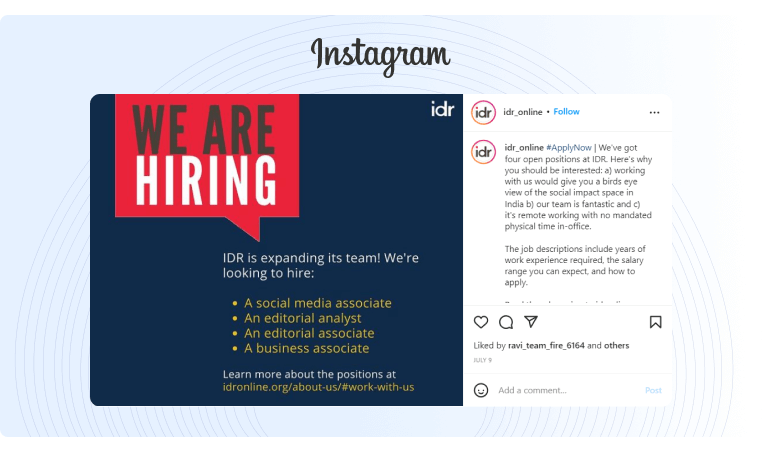 You will also need to have a strong presence on the platform for potential candidates to take you seriously. Mastering the platform, especially newer features such as Reels, can take considerable time and effort. However, if done correctly, Instagram can provide excellent reach.
You will also need to have a strong presence on the platform for potential candidates to take you seriously. Mastering the platform, especially newer features such as Reels, can take considerable time and effort. However, if done correctly, Instagram can provide excellent reach.
TikTok
TikTok, which caters to a younger demographic, is perhaps the most trendy social media platform on this list. However, despite its limited demographic, it’s an extremely influential platform that can help your recruitment process.
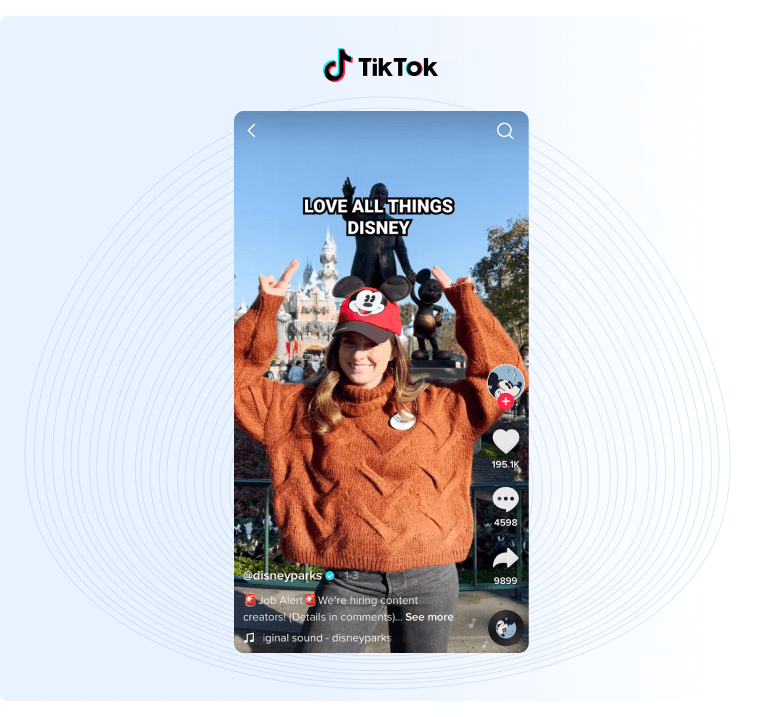
TikTok noticed the rise in career and job-related content on their app and introduced “TikTok Resumes” in 2021. This pilot program lets partner companies post job openings on TikTok. Interested candidates can submit short video resumes as their applications. This method has a high creativity and engagement quotient and allows potential candidates to showcase their skills and fit uniquely.
Benefits of Social Recruitment
Companies can significantly benefit from the reach that social media offers without incurring the high costs typically associated with advertising and traditional recruitment methods. Here are some advantages of using social recruitment:
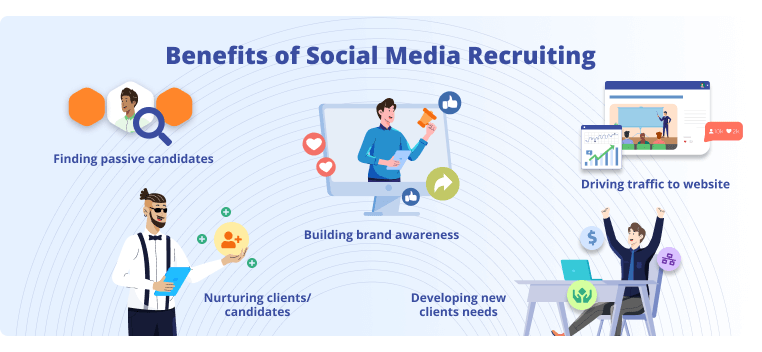
Improve Reach
Given the widespread adoption of social media, it offers much better reach than traditional forms of recruiting. It’s easy to tap your and your employees’ social networks to reach a wider audience. Exploring your immediate networks makes it more likely that you find suitable candidates.
Find Passive Candidates
Most traditional forms of recruitment, such as job boards, are only visited by those actively looking for jobs. However, social media allows you to tap into the vast pool of passive candidates, one of the most efficient ways to increase your reach.
As the name suggests, passive candidates are those who aren’t actively looking for a job. They might be content with their current employment but open to learning about opportunities that would advance their career.
Everyone scrolls through social media regardless of whether they are actively seeking jobs. If you advertise your job opening on social media, it’s more likely to be seen by passive candidates who might apply if they believe they are the right fit.
The most significant advantage of passive candidates is that they might choose to apply for your job out of genuine interest instead of desperation to leave their current job or gain employment.
Save on Recruitment Costs
Recruitment can be a lengthy and expensive process; a significant amount of resources are spent on hiring the right talent. According to a recent report by Society for Human Resource Management (SHRM), the average cost of hiring a new employee is approximately $4,683. It can be nearly three times the salary of the position you’re hiring for if you consider soft costs.
Most social media accounts are free to set up and don’t require recruiters to opt for paid job postings. The power of social media is your ability to leverage your employees’ social networks and word-of-mouth advertising to reach the maximum number of potential candidates with the least amount of money and time spent.
Develop Your Brand as an Employer
It has become increasingly difficult not just to hire but also to retain employees. In 2021, more than 40% of employees were thinking about leaving their current jobs. According to MIT Sloan Management Review’s research, a toxic work culture is one of the strongest motivators for employees to quit. While most people believe that wages are the biggest contributor to employee resignations, a toxic work culture is 10.4 times more powerful than compensation in predicting a company’s attrition rate.
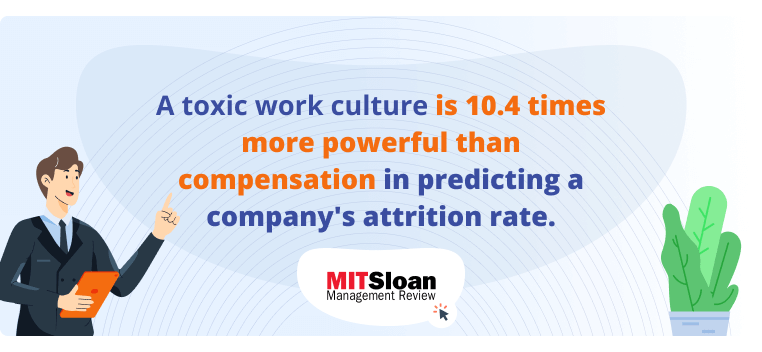 Social media allows you to develop and showcase your company’s brand. Share your company culture and values alongside your job postings, facilitating a conversation between your company and job seekers, before the hiring process even starts. This allows you to attract better talent and reduces the chances of rejection since potential employees know your work culture.
Social media allows you to develop and showcase your company’s brand. Share your company culture and values alongside your job postings, facilitating a conversation between your company and job seekers, before the hiring process even starts. This allows you to attract better talent and reduces the chances of rejection since potential employees know your work culture.
Using platforms such as Instagram and TikTok is a great way to stay current and showcase your culture to potential employees. Use employee-generated content, such as current employees sharing their experience at your company, to build your social media presence and trust signals with your audience. Don’t be afraid to hold live-streaming sessions on YouTube or Instagram to increase engagement with future recruits, too.
Use Social Media to Your Advantage
If you rely only on traditional forms of recruitment, you’re probably ignoring a vast talent pool that might be an excellent fit for your company. Current trends demonstrate high usage of social media in recruiting, and companies ignore its importance at their peril.
The most significant advantage of social recruiting is its ability to improve your reach by an order of magnitude while mitigating the costs imposed by traditional recruitment methods. It also enables you to develop your brand on social media by producing content that highlights your company culture, which leads to a higher number of applications as well as better quality of applicants.









